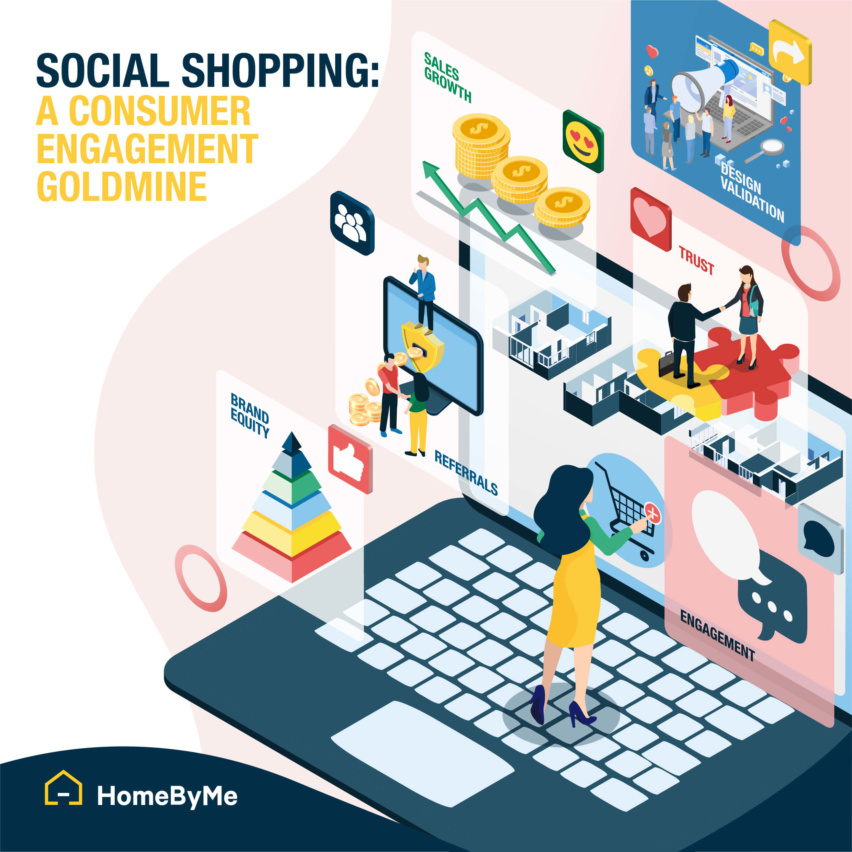When it comes to high-value purchases, like furniture for a home remodeling project, social shopping is more about feedback and validation from peers.
It is no secret that the use of social media has skyrocketed. With more users on these platforms than ever before, global adoption has paved the way for new retail strategies, not least social shopping. New research suggests the number of businesses selling via social media will double in the next six months. In the UK alone, this means Brits will soon be able to buy products on Instagram, Facebook, Snapchat and more, from an extra 600,000 retailers – a trend that is happening all over the world.
Among fast-moving consumer goods (FMCGs), a reported three-quarters of buying decisions are now informed by what is seen on social media. These platforms have become an important channel for product discovery as much as purchase. But for those in the home retail space, a somewhat different social shopping approach is required to tap into this trend, increase conversions, and attract new consumers through referral.
The rise of social shopping
When it comes to high-value purchases, such as furniture for a home remodeling project, social shopping is more about feedback and validation from peers than it is about placing an order. These items are typically considered for longer and follow a more complicated sales cycle when compared with FMCGs; there is a non-linear path from discovery to final delivery.
Part of the reason is human nature. Confidently visualizing an end objective is tricky, particularly when it’s how furniture will look in the home. This is why receiving feedback from friends and family before making a high-value purchase is considered so important. In fact, two-thirds of us seek recommendations when shopping, which has become an ingrained factor in the sales journey that is hard to circumnavigate.
Rather than trying to find ways to alleviate this concern, home retailers should embrace it. By providing customers with a seamless digital experience that integrates with the social shopping phenomenon, they can cater to consumer need for social sharing and engagement in a way that also supports the sales cycle.
Perfecting this seamless experience depends on the right technology. New platforms, such as the HomeByMe for Home Retailers 3D planning solution, are the missing link between high-value retail purchases and the social shopping economy – offering a host of benefits for consumers and retailers alike.
Streamlining social approval
Improving the social feedback loop for consumers first depends on tackling the inherent issue of visualization. The latest white-label 3D planning solutions, for example, make it easy for consumers to design a virtual version of a room in their home with high-definition, digitized versions of furniture from the retailer’s product catalog.
Once the visualization hurdle has been overcome, modern 3D planning platforms can cater for the second need through an in-built sharing functionality that makes it easy to show family and friends a living, interactive version of their design.
By enabling consumers to create new designs and share their creations on social media, retailers can meet their needs in a way that drives additional traffic and engagement. And as their designs are permanently stored in the cloud, they’re available forever. In turn, this adds additional value that keeps them coming back time and time again.
Compounding trust for retailers
For retailers, the benefits of an approach like this are two-fold: indirectly targeting consumers’ family and friends, and becoming more creative with social selling to drive traffic from social networks.
When consumers share their designs, this is done through the platform which enables their friends and family to experiment with the 3D solution of their own accord. This has the added benefit of creating another stream of referral traffic. And that traffic is directed to part of the retailer’s site that is inherently more engaging than a simple product page.
Putting a 3D planning solution at the heart of their offering like this also allows home retailers to be more creative in social selling. Of course, promoting a new product line on social media in the traditional way is still of value, but rather than a “buy now” call to action, retailers could consider including a “design now” alternative.
This would immediately direct new users to the solution in order to create their own home redesigns, while existing customers could update their latest templates to see whether a product is a good fit. Recommendations and alerts could then be offered based on the user’s behavior and design preferences.
User-generated content like this can be used to amplify the ROI around social promotion, too. Data from the platform can suggest what products are garnering the most interest, and therefore should get the highest percentage of social promotion spend.
Designing for the future of social shopping
Ultimately, none of this is possible without having a 3D planning solution that’s available on a retailer’s website as well as in-store. Just as consumers look for feedback from their friends and family when considering a high-value purchase, validation from a professional is key to closing a sale.
Home retailers that implement the right technology to capitalize on this demand across platforms and devices, will be the ones that build the strongest relationships, drive the greatest conversion rates, and encourage repeat business from social traffic.



